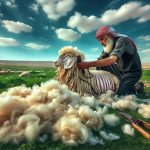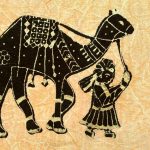Do you ever wonder what makes cashmere wool so special? Well, you’re about to find out.
Cashmere wool is a luxurious fabric that comes from the undercoat of cashmere goats. It is renowned for its incredible softness, warmth, and durability.
In this article, we will explore the origins, characteristics, production process, and types of cashmere wool. We will also delve into the benefits, care, and sustainable aspects of this remarkable fabric.
Plus, we’ll share some styling tips to help you rock your cashmere wool garments with confidence.
Get ready to fall in love with cashmere wool!
Table of Contents
The Origins of Cashmere Wool
The Origins of Cashmere Wool can be traced back to the Himalayan region. This luxurious fabric comes from the undercoat of cashmere goats, which are primarily found in countries like India, Nepal, and Mongolia. The production process of cashmere wool is a fascinating one.
It all starts with the herders carefully combing the goats’ fleece during the spring molting season. This is when the goats naturally shed their winter coat, leaving behind the fine cashmere fibers. The herders then collect these fibers, which are incredibly soft and light, and sort them by color and quality.
Next, the fibers go through a thorough cleaning process to remove any impurities. They are soaked in water and gently washed to get rid of dirt and oils. Once cleaned, the fibers are carefully dried and then sent to the spinning mill.
In the spinning mill, the cashmere fibers are twisted together to create yarn. This yarn is then woven into fabric using traditional methods or modern machinery. The result is a fabric that is incredibly soft, warm, and durable.
Overall, the origins of cashmere wool can be traced back to the Himalayan region, where the production process starts with the careful collection and cleaning of the cashmere fibers. The end result is a luxurious fabric that is highly sought after for its exceptional quality.
The Characteristics of Cashmere Wool
Cashmere wool is known for its incredible softness and warmth, making it a popular choice for luxurious and cozy garments. It is prized for its lightweight nature, which allows for comfortable and effortless wear.
Additionally, cashmere wool is a natural fiber that provides excellent insulation, making it ideal for colder climates.
Softness and Warmth
Its softness and warmth make cashmere wool a luxurious fabric. When it comes to styling tips, cashmere wool can elevate any outfit. Here are three ways you can incorporate cashmere wool into your sustainable fashion wardrobe:
-
Layer it: Cashmere wool is lightweight, making it perfect for layering. Add a cashmere wool cardigan or sweater over a basic tee for a cozy and chic look.
-
Accessorize with it: Cashmere wool scarves or beanies are not only fashionable but also functional, keeping you warm during colder months.
-
Invest in timeless pieces: Cashmere wool is a durable fabric that can last for years if properly cared for. Consider investing in a cashmere wool coat or a classic cashmere wool sweater that you can wear season after season.
Luxurious and Lightweight
When it comes to luxury and comfort, nothing compares to the lightweight feel of cashmere. This high-quality fabric is not only incredibly soft but also remarkably lightweight and breathable. Cashmere’s lightweight nature allows it to provide warmth without feeling heavy or bulky.
The fibers are spun from the soft undercoat of cashmere goats, resulting in a fabric that is exceptionally fine and lightweight. This makes cashmere an ideal choice for garments and accessories that prioritize comfort and elegance.
However, the exquisite qualities of cashmere come at a price. Due to the labor-intensive process of harvesting and processing the fibers, cashmere is considered a luxury material and can be quite expensive. Nevertheless, the lightweight and breathable characteristics of cashmere make it a worthy investment for those seeking unparalleled comfort and sophistication.
Natural and Insulating
Though pricier than other materials, cashmere offers natural insulation that keeps you warm in colder temperatures. Here are three reasons why cashmere is a great choice for keeping you cozy:
-
Natural Fibers: Cashmere is made from the fine hairs of cashmere goats, which are softer and warmer than regular wool. These natural fibers trap air and create a layer of insulation, helping to regulate your body temperature.
-
Environmental Impact: Cashmere is a sustainable option compared to synthetic fabrics. Cashmere goats are raised in herds, grazing on natural vegetation, which reduces the need for chemical pesticides and fertilizers. Additionally, the production process of cashmere has a lower carbon footprint compared to synthetic fabrics.
-
Longevity: Cashmere is known for its durability and longevity. With proper care, cashmere garments can last for many years, making it a worthwhile investment.
The Production Process of Cashmere Wool
To produce cashmere wool, you need to start by shearing the hair from the cashmere goats. These goats are raised in various regions around the world, including Mongolia, China, and Iran, where the climate and grazing conditions are ideal for their growth. The production process of cashmere wool involves several steps, from shearing the goats to processing the fibers into yarn.
Once the hair is sheared from the goats, it goes through a thorough cleaning process to remove any impurities. This includes removing dirt, grease, and any other foreign matter from the fiber. After cleaning, the hair is sorted based on its quality and color. The highest quality cashmere fibers are the longest and finest, and they are usually the softest and most luxurious.
To give you a better understanding of the production process, here is a table that outlines the key production techniques and their environmental impact:
| Production Technique | Environmental Impact |
|---|---|
| Shearing | Minimal |
| Cleaning | Moderate |
| Sorting | Minimal |
| Spinning | Moderate |
| Dyeing | Moderate |
Overall, the production of cashmere wool requires careful management to minimize its environmental impact. Steps are being taken by manufacturers and producers to ensure sustainable practices, such as responsible grazing and water conservation, are implemented.
The Different Types of Cashmere Wool
There are three main types of cashmere: white cashmere, brown cashmere, and gray cashmere. Each type of cashmere has different characteristics and qualities that make them unique.
Here’s a breakdown of the different types of cashmere and what sets them apart:
-
White cashmere: White cashmere is the most common type of cashmere. It is known for its softness, warmth, and versatility. White cashmere is often used to make luxurious sweaters, scarves, and blankets. It is highly sought after for its pure and clean appearance.
-
Brown cashmere: Brown cashmere comes from goats with a brown coat. This type of cashmere is less common but still highly valued. Brown cashmere has a rich, earthy tone and is often used to create unique and stylish garments.
-
Gray cashmere: Gray cashmere is another popular type of cashmere. It comes from goats with a gray coat and has a unique and sophisticated look. Gray cashmere is often used to make elegant and timeless pieces that can be dressed up or down.
When it comes to different grades and cost factors of cashmere, there are a few things to consider. The grade of cashmere refers to the quality and fineness of the fibers. Higher-grade cashmere is softer and more luxurious, but it also comes at a higher cost. Other cost factors include the source of the cashmere, the manufacturing process, and the brand.
Overall, cashmere is a luxurious and highly prized fabric that offers warmth, softness, and style.
The Benefits of Cashmere Wool Fabric
Cashmere wool fabric offers a luxurious and soft texture that is unmatched by other materials. Not only does it feel incredibly comfortable against your skin, but it also provides excellent insulation properties to keep you warm in the colder months.
Additionally, cashmere wool fabric is known for its long-lasting and durable nature, making it a worthwhile investment for your wardrobe.
Luxurious and Soft Texture
Feel the luxurious and soft texture of cashmere against your skin. Cashmere wool fabric is known for its exquisite feel, making it a popular choice for high-end clothing and accessories. Here are three reasons why the texture of cashmere is so special:
-
Fine fibers: Cashmere is made from the fine undercoat of cashmere goats. These fibers are extremely soft and lightweight, giving cashmere its signature luxurious texture.
-
Insulation: Cashmere is an excellent insulator, providing warmth without adding bulk. The natural air pockets within the fibers trap heat, keeping you cozy in colder weather.
-
Durability: Despite its delicate feel, cashmere wool is surprisingly durable. The long, strong fibers make it resistant to pilling and stretching, ensuring that your cashmere garments will last for years to come.
Experience the indulgent sensation of cashmere against your skin and enjoy the many benefits it offers.
Excellent Insulation Properties
Stay warm and cozy without adding bulk by experiencing the excellent insulation properties of cashmere against your skin. Cashmere wool is renowned for its ability to trap air between its fibers, creating a natural barrier against the cold. This insulation not only keeps you warm but also helps conserve energy by reducing the need for artificial heating.
The unique structure of cashmere fibers allows them to retain heat efficiently, making it a perfect choice for winter wear. Additionally, cashmere is an environmentally friendly option compared to synthetic materials. It is a renewable resource as it comes from the soft undercoat of cashmere goats, which are shorn annually without causing harm.
Long-Lasting and Durable
When cared for properly, cashmere garments can withstand years of use, thanks to their long-lasting and durable nature. Here’s why cashmere is known for its longevity and quality:
-
Natural fibers: Cashmere is made from the soft undercoat of cashmere goats, which gives it exceptional strength and durability.
-
Insulation properties: Cashmere is known for its ability to provide warmth without adding bulk, making it a versatile option for various climates and seasons.
-
Timeless style: Cashmere garments are classic and timeless, making them a worthwhile investment for your wardrobe. Whether it’s a cozy sweater or a luxurious scarf, cashmere adds a touch of elegance and sophistication to any outfit.
With its longevity and quality, as well as its versatility and style, cashmere is a must-have fabric for those seeking comfort and fashion-forward pieces.
How to Care for Cashmere Wool
Taking proper care of cashmere wool is essential to maintain its softness and longevity. By following these caring techniques and storage advice, you can ensure that your cashmere wool garments remain in excellent condition for years to come.
Caring Techniques:
| Caring Technique | Description |
|---|---|
| Hand Washing | Gently wash cashmere by hand in cold water using a mild detergent. Avoid wringing or twisting the fabric. |
| Drying | Lay the garment flat on a clean towel and reshape it. Avoid hanging or wringing to prevent stretching. |
| Ironing | Use a cool iron or steamer to remove wrinkles. Always iron on the reverse side to protect the delicate fibers. |
| Pill Removal | Carefully remove any pills or fuzz balls using a cashmere comb or fabric shaver. |
| Storage | Store cashmere in a clean, dry place, preferably folded and placed in a breathable garment bag or sealed container. |
Proper care and storage will help maintain the softness and luxurious feel of your cashmere wool garments. By following these guidelines, you can enjoy the comfort and elegance of cashmere for many seasons to come.
The Sustainable Aspects of Cashmere Wool
To minimize your environmental impact, consider purchasing cashmere garments made from recycled fibers. Sustainability and ethical sourcing are becoming increasingly important factors to consider when purchasing clothing. Here are three reasons why choosing recycled cashmere can make a difference:
-
Reduced carbon footprint: By opting for recycled cashmere, you are supporting a more sustainable production process. The use of recycled fibers helps to reduce the demand for new materials and decreases the carbon emissions associated with the creation of virgin cashmere.
-
Conservation of resources: Cashmere is derived from the soft underbelly hair of goats. By choosing recycled cashmere, you are reducing the need for additional goats to be raised and bred solely for their fiber. This helps to conserve resources such as land, water, and food that would otherwise be required for goat farming.
-
Ethical treatment of animals: The sourcing of cashmere from recycled fibers ensures that no new animals are harmed or exploited for their wool. This promotes ethical practices in the fashion industry and supports the well-being of animals.
Styling Tips for Cashmere Wool Garments
Pair your cozy cashmere sweater with high-waisted jeans and ankle boots for a chic and effortless look. Cashmere wool fashion is timeless and versatile, making it a staple in any wardrobe. Whether you’re dressing up for a special occasion or keeping it casual for a day out, there are endless ways to style your cashmere garments.
To stay on-trend with cashmere wool fashion, consider incorporating these key pieces into your wardrobe:
| Chunky Scarf | A chunky cashmere scarf adds both warmth and style to any outfit. Opt for neutral colors like gray or camel for a classic look. |
| Cardigan | A cashmere cardigan is a versatile piece that can be worn open or buttoned up. Pair it with a blouse and trousers for a sophisticated office look, or layer it over a dress for a cozy yet elegant ensemble. |
| Beanie | Keep your head warm and stylish with a cashmere beanie. Choose a bold color like burgundy or mustard to add a pop of color to your winter outfits. |
| Gloves | Cashmere gloves not only keep your hands warm but also add a touch of luxury to your winter accessories. Opt for a pair with touchscreen capability for convenience. |
Conclusion
In conclusion, cashmere wool fabric is a luxurious and highly sought-after material. Its origins can be traced back to the mountain regions of Asia, where the cashmere goat produces its fine and soft fibers.
With its unique characteristics of warmth, softness, and durability, cashmere wool is a favorite choice for high-quality garments. By understanding the production process and types of cashmere wool, you can make informed decisions when purchasing and caring for these garments.
Embrace the sustainable aspects and enjoy styling your cashmere wool garments for a timeless and elegant look.
- A Beginner’s Guide to Nonwoven Fabric Types - July 11, 2025
- Spunbond vs. Spunlace: What’s the Difference in Nonwoven Fabrics? - July 11, 2025
- The Ultimate Comparison: Woven vs. Nonwoven Fabric Properties - July 11, 2025






